Black Orpheus, 1959, directed by Marcel Camus, screenplay by Jacques Viot, from the play Orfeu da Conçeicão by Vinicius de Moraes.
Critics often write about movies as though they exist in a vacuum. Although they'll trace one filmmaker's influence on another, the ways a film can bleed into the rest of the culture isn't usually part of the conversation (the notable exception is right-wing pundits blaming Hollywood for America's moral decline). I'm not really that interested in talking about movies destroying our moral values (and that conversation is only tangentially about movies). Movies that change the landscape for other kinds of art, though? Yeah, that interests me. One example: I left the United States for Italy in September of 1994, about two weeks before Pulp Fiction was released. Although I saw it while abroad, I didn't think it was going to be more influential than, say, Forrest Gump (its rival at the Academy Awards that year). The next July, on my second day back in the states, I saw a commercial for Crest toothpaste with a surf rock soundtrack. Tarantino had changed what that kind of music meant, and in just ten months it had trickled down to toothpaste ads. For the next five years or so, every time a band at a party launched into a half-assed cover of "Misirlou," I had Tarantino to blame.
Black Orpheus is also one of those movies that bled from one kind of art into another. Marcel Camus didn't inspire the kind of devotion among filmmakers that Tarantino did. But Black Orpheus changed the music world, introducing the west to Latin American music. So when that cover band stops playing Dick Dale and goes into "The Girl from Ipanema," you've got Camus to thank (or curse). Black Orpheus is filled with music from the first frame to the last. The songs were written by Luiz Bonfá and Antonio Carlos Jobim, and they still show up in movie soundtracks, most recently in Casa de los Babys. As far as their bossa nova credentials go, try this: Jobim's the guy who actually wrote "The Girl From Ipanema." So the movie's worth seeing for the music alone, which is good, because I wasn't blown away by the rest of it.
Black Orpheus is a retelling of the myth of Orpheus and Eurydice, set in the favelas of Rio de Janeiro. In the myth, Orpheus is a gifted musician; as played by Bruno Mello, he's also a streetcar conductor.
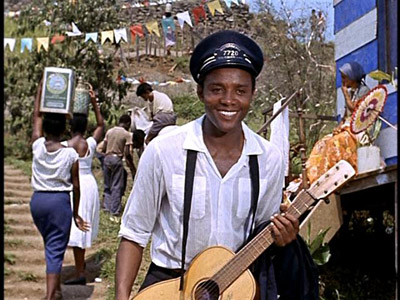
His low-paying job makes him seemingly the most employed man in his whole neighborhood, a slum of epic squalor overlooking the city. Rio is the one city where traditional housing patterns are reversed: the rich live at sea level, while the poor get views like this:
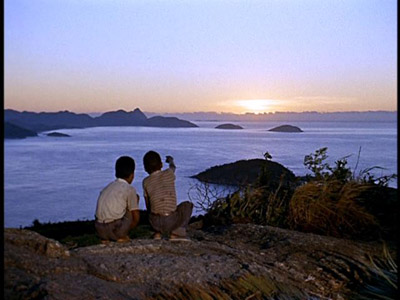
Those kids are watching the sunrise because they believe Orpheus's music literally makes the sun come up. He's something of a local hero among the adults of the neighborhood as well, which is why his fiancé is so hellbent to get married. The first half of the movie or so is a pretty conventional love triangle between his fiancé, Mira, and Eurydice, his true love. Mira is played with aplomb by Lourdes de Oliveira. It's not a particularly difficult role, since Mira is basically enraged at someone from frame one to the end. Usually, it's Orpheus, although in the still below, she's mad at a clerk:
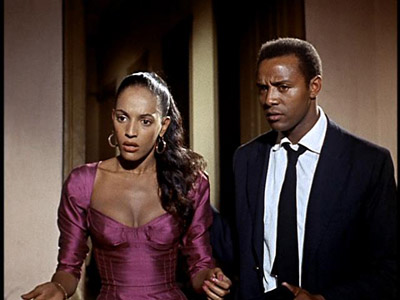
Eurydice, played by the jaw-dropping Marpessa Dawn, has to look dreamily in love for most of the movie. And she's very good at it:

If you know your mythology, you know Eurydice isn't long for this world. Which is good, because although Camus's version spends most of its time with Eurydice still alive, the love story feels prefunctory. Not to say the early sections of the film are boring: Camus has a tourist's enthusiasm for Rio, and the settings are gorgeous. The movie takes place during Carnival, when the favela's samba school is preparing for the parade. Here's part of the parade:
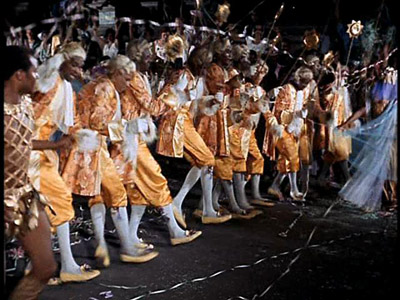
As you can see, Jean Bourgoin's cinematography is a really vibrant technicolor throughout. The colors are at least as bright as The Red Shoes. But Black Orpheus doesn't really get interesting visually until Eurydice is dead. After running through the depressing wreck that Carnival becomes when it's over (police rounding people up, drunks passed out on the streets, &c.), he arrives at the bureau of Missing Persons, possibly the most depressing building in South America.
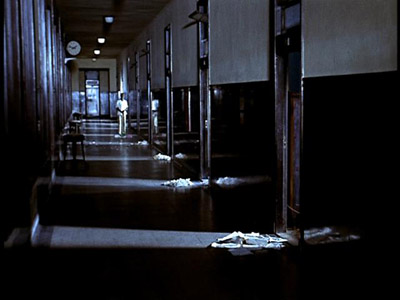
I didn't get a still of the exterior (nor do I know what building Camus actually used) but it's as inhuman as anything in Brasília. My favorite shot in the movie is of Orpheus being led downstairs from the Bureau of Missing Persons: the red light on the ground floor tiles makes it look like he's descending into a pool of glowing lava.
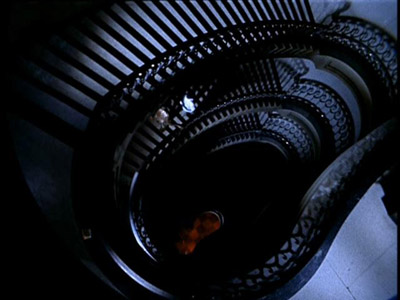
I'm skeptical that those stairs are in the same building as the exteriors, but I love them. (Incidentally, Insomnia also has an oval variation on the stairway-as-maze shot, so we're two in a row now). Less cool than the above: the lowest depths of the underworld, represented by a Macumba ceremony, although I did like the priest:
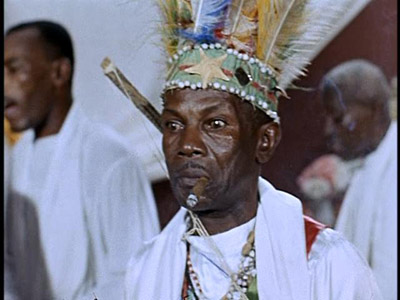
Now that's a religious leader I could get behind: stone crazy. Camus shows maybe five minutes of this ceremony, and to me, this was the worst scene in the movie. The whole film walks a fine line between focusing on its characters and being a combination travelogue and introduction to bossa nova. The Macumba ceremony goes far enough towards travelogue to feel anthropological. It should be the emotional high point of the film; it's Orpheus's last contact with Eurydice (and the core of the original myth). Maybe it's just my ADD, but staging it during this ceremony seemed distracting to me.
And I guess that was my real problem with this film: it is clearly a celebration of Rio, but it seems at times to focus on being enthusiastic about the city and its music at the expense of its characters. I really didn't find Orpheus, Mira, or Eurydice remotely believable. Not that I know much about it myself, but I suspect that life in the favelas involves more than singing, dancing, and spectacular sunrises. And I'm not a hard-liner about racial stereotypes, but surely I'm not the only person who squirms when a film features a lazy black man chasing after a slice of watermelon.
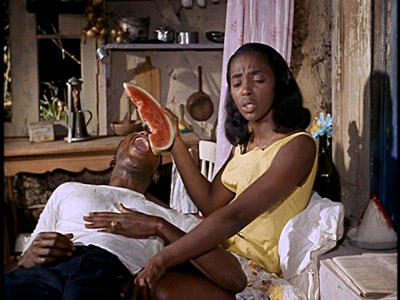
This is one of those cases where it matters who made the film. I first saw it when a friend who'd lived in Brazil the previous year recommended it to me; I was kind of baffled as to what she saw in it. Talking to her about it later, it became clear that she'd believed the movie was made by a Brazilian, not a white Frenchman. If it were the work of an insider, Camus's condescending view of poverty and flirtation with racial stereotypes would be more forgiveable. But there aren't any insider filmmakers in the favelas of Rio. Fernando Meirelles and Kátia Lund are the closest thing I can think of, and they both grew up in the suburbs of São Paulo. Discussions of authenticity are always a little uncomfortable, and I'm one of the least authentic, most waspy wasps you'll ever meet. So I'm uniquely unqualified to talk about stereotyping or snipe at Camus for being out of line. Still, I have a (probably misguided) sense of who's allowed to say what. Jessy Terrero gets to make Soul Plane and even Stepin Fetchit is undergoing cultural rehabilitation and I don't have a problem with either thing. But the watermelon scene in Black Orpheus made me genuinely queasy.
Anyway, scratch too deeply at anyone's feelings about race and authenticity and you're staring into the abyss (or worse still, watching Crash). That's a discussion for a different place. With Black Orpheus, you'd do better to just enjoy the scenery and music. Camus is smart enough to bring those two elements back together at the end of the film, when one of the neighborhood kids takes on Orpheus's duty of making the sun rise. But unlike Orpheus, who tended toward mournful ballads, the kid's song is fast and infectuous. Whatever you think about the rest of the film, it's impossible to watch the ecstatic ending without being sucked in. It's a pity the rest of the film isn't as fluid and seductive.
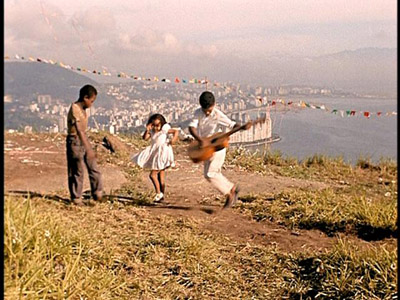
Randoms:
- Bosley Crowther's original review of the movie for the New York Times is available online. It's quite a read: the review is shot through with phrases like "she conveys more forthright emotion than does the non-terpsichorean man." He also uses the royal we. On the whole, it reads a bit nineteenth century (or at least early twentieth). Crowther was in his fifties when he wrote it. How then, to explain the last paragraph?
The language spoken, incidentally, is Brazilian Portuguese, which is translated in English subtitles that completely lack the samba beat. A cat with a cool vocabulary should have been turned loose on them.
Maybe I'm missing something here, but that seems a little out of place.
- Lourdes de Oliveira earns a place in my personal hall of fame for her unbelievably spectacular... sleeves. You can see them pretty clearly in the still below; that's her Carnival costume. But a still photograph doesn't do justice to the force-of-nature impact of watching them move as she dances. Because, um, they're ruffled. Her sleeves are ruffled.
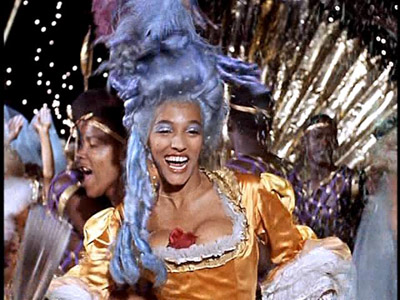
- Seu Jorge, who's in City of God and The Life Aquatic With Steve Zissou, actually did grow up in the favelas. So if he ever starts making his own movies, there'll be an undeniably authentic movie about that world. I haven't seen Life Aquatic recently, but it seems to me that Jorge is doing his best Bruno Mello-as-Orpheus impression.


11 comments:
Life Aquatic is spine number 390, so I'm betting you'll be watching it a couple years down the road. ;)
Have you checked to see if any of the questionable scenes are in the original play? I don't know much about Vinicius de Moraes, but according to Wikipedia he was at least from Rio (although perhaps not from the favelas).
Oh, come on, Rog, it's spine number 300, not 390! At one movie a week, I'll be there by the spring of 2011; no time at all. By that point, of course, Criterion will have long since abandoned DVD for Blu-Ray and this site will be an anachronism.
J.P., I haven't--as far as I can tell, there was never an English translation of the play. And a casual search of a few library catalogs would seem to indicate that the last Portuguese publication was in 1967--the NYPL had a copy but it's listed as "Currently Unavailable for Checkout." And that's all the research I'm going to do on that. Regardless of whether that scene is in the play, I think I would at least have changed what the guy was eating; it's the same question as how Jewish you make Fagin in Oliver Twist. Except really it should be a simpler question because in Black Orpheus, it's just a short, tangential thing, not an integral part of the story. The tone of the scene, by the way, is affectionate and comic; it's not like it's a racist movie. It's just a really jarring image.
I find it strange that you look for social political correctness in the retelling of a myth.
The man who eats the melon is a sailor who rarely gets home. He is fed a fruit by his lover after making love we suppose. This couple who is all about joy and simplicity is there to provide a contrast with the oh so serious and intense Orpheus/Euridyce couple. Maybe it is a reference to the fruits of life as opposed to the fruits of hell.
This is one of my favourite films ever. It never fails to make me cry. MAybe it's a girl's film :=)
thanks for the post! i am looking forward to revisiting this beloved work.
xoxo,
Cy
I enjoyed seeing the movie again. The scenes inside their homes brought back memories of when I grew up in the rural South - no locked doors! Amidst the pains of oppression, my childhood was filled with many moments of joy. I remember the gentle teasing with cousins, our sneaking peeks of older relatives who had begun courting, my running barefoot through God's creation, and most of all, enjoying the beauty of the world around us - the bugs, the sunrise, the sunset, the stars, the fishing, ... I was not offended by the "stereotypes" in the movie, even though I am African-American and 57 years old. The music brought back fond memories. At this viewing, I appreciated that a movie made in the 1950s used so many actors of my complexion - I was glad the actors had the opportunity. The story was simply told. I was caught up with Eurydice, Orfeo and Mira because, for me, the emotions rang so true. These characters are very young people, set in the first half of the twentieth century. Perhaps, the teasing of the male lover with a slice of watermelon was a poor choice of a prop, and the humor attempted probably would have been just as good with another fruit choice. However, I truly enjoyed the movie, its music, its story, its color, and best of all - the children! They were observant of things, as all children are, when we adults might not be aware that they are; and, they were seemingly oblivious to other things (such as the deaths of Orfeo and Eurydice) as they continued on in their celebration of life at the end of the movie.
Al,
Thanks for the thoughtful and evocative comment. In the time since I last saw the film, its occasional stereotypes have faded in my memory, but the music, and especially the final scene, have stayed with me.
very sensible movie i loved it pls do watch it
I agree that “life in the favelas involves more than singing, dancing, and spectacular sunrises.” It’s true there are no mosquitoes in the favelas of Black Orpheus, but to criticize this film because it has little to do with the reality of the favelas is to criticize it for failing to attain something to which it never aspires. I think it’s important to bear in mind these lyrics sung early in the film:
The happiness of the poor
Is like the great illusion of Carnival
The poor work all year round
For a moment’s dream
-- A Felicidade
Carnival is admittedly an illusion. Black Orpheus, in focusing on this “moment’s dream”, doesn’t deny the existence of the mosquitoes and squalor that were certainly rampant in the favelas. In its way, the extravagance of Carnival highlights the wretchedness of the everyday.
Characterization and narrative are not this film’s strong suits. But at least they are not distractingly bad. They are the fairly innocuous frameworks upon which hangs all the really important stuff: the color, the movement, the sustained beat. The beat of Black Orpheus can, if you succumb, take you on a journey much like that of a DJ at a really great after hours (I'm drawing on some distant memories here). Black Orpheus does for Rio what Summertime does for Venice. And it was gratifying to learn that Black Orpheus is in part responsible for my acquaintance with my favorite CD of all time, Getz/Gilberto featuring Antonio Carlo Jobim and introducing “The Girl From Ipanema.”
I think you may have overreacted to the watermelon. I did some (cursory) online research. It seems as though the watermelon stereotype is specifically American and outside of America not widely known. I’m betting it was a completely arbitrary fruit selection on Camus’ part, and while I understand your reaction, I wonder if anyone but an American would react as you (and a little bit me) did.
Happy Holidays! And now excuse me while I go and download the soundtrack to Black Orpheus.
I remember seeing this film for the first time like it was yesterday. I didn't know what I had watched, but I loved every second of it.
Post a Comment